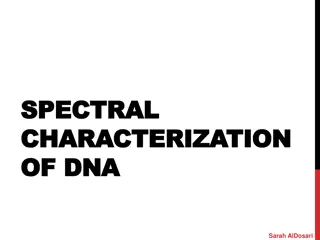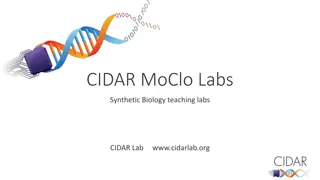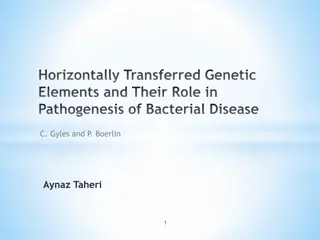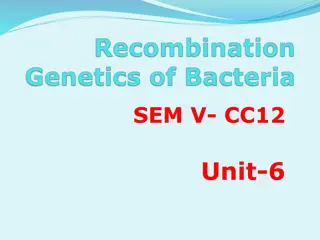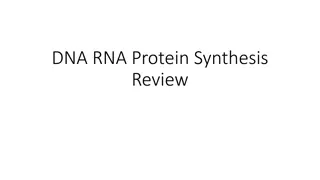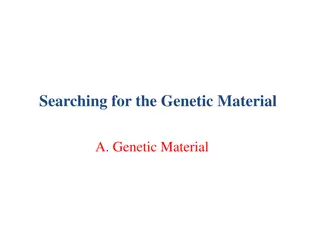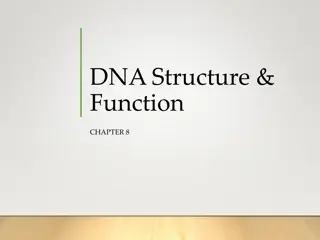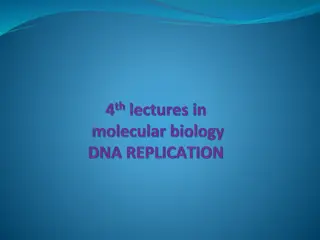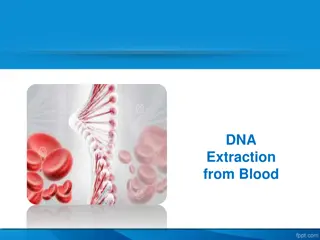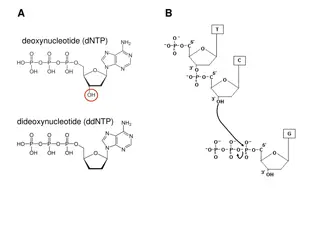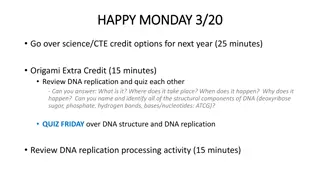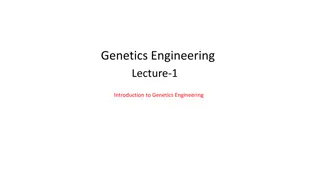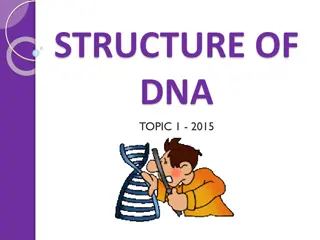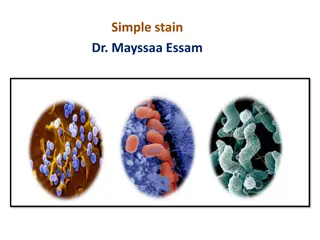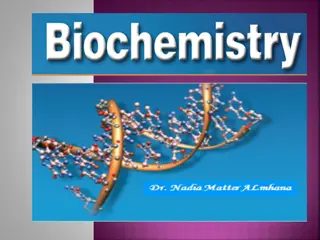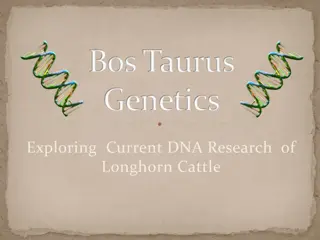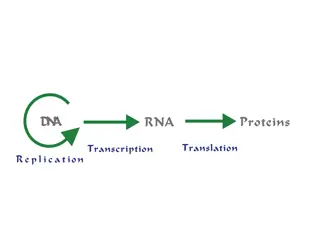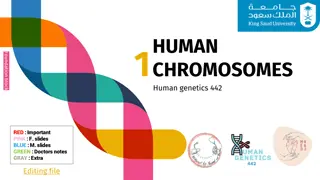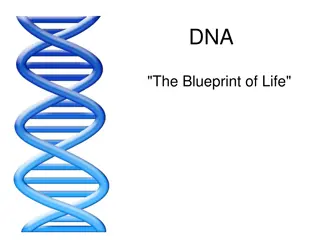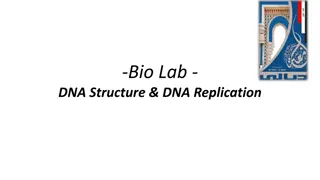Understanding Bacterial Genetics and DNA Structure
Explore the intricate world of bacterial genetics and DNA structure. Genes dictate the characteristics of bacteria, with each gene controlling specific properties. The double-stranded DNA structure, consisting of nucleotides and nitrogen bases, carries vital genetic information. Discover how genes are arranged along the circular DNA, forming the genome, a complete set of genes defining an organism's genetic makeup. Delve into chromosome function in protein synthesis, involving transcription, mRNA translation, and the role of different types of RNA in bacteria.
Download Presentation

Please find below an Image/Link to download the presentation.
The content on the website is provided AS IS for your information and personal use only. It may not be sold, licensed, or shared on other websites without obtaining consent from the author. Download presentation by click this link. If you encounter any issues during the download, it is possible that the publisher has removed the file from their server.
E N D
Presentation Transcript
Bacterial genetics Genetics define & analyze heredity. The unit of heredity is the gene which is a segment of DNA that carries information for specific biochemical or physiological properties. Each characteristic of bacteria is controlled by a specific gene. DNA:- genetic information which is stored as a sequence of bases in deoxyribonucleic acid (DNA).
DNA Structure Double stranded Nucleotide Nitrogen Bases Sugar Phosphate Base Pairs Hydrogen Bonds A-T C-G Alpha helix 5 phosphate group 3 hydroxyl group
The complementary bases enable one strand to provide the information for copying or expression of information in other strand. Each base determines the genetic information of DNA. DNA is a circular single closed loop found in the cytoplasm of bacteria. This DNA carries the gene. DNA loop
Genes present along the circle of DNA. Genes present along the circle of DNA. Number & one bacterium to another. one bacterium to another. Number & location of gene on DNA differ from location of gene on DNA differ from Some bacteria have several hundreds or thousands of genes. Some bacteria have several hundreds or thousands of genes. GENOME: GENOME:- - is a complete set of genes ( is a complete set of genes (more than one gene that carry the information more than one gene that carry the information & & characters of microorganisms). characters of microorganisms). Genome also can be identified as the totality of genetic information in the organism. Genome also can be identified as the totality of genetic information in the organism.
Chromosome function ( Chromosome function (protein synthesis): protein synthesis):- - In protein synthesis there is: In protein synthesis there is: DNA DNA------- ------- transcription transcription mRNA mRNA translation translation Protein Protein Each amino acid has at least a triplet bases for each codon. Each amino acid has at least a triplet bases for each codon. There is an anticodon which is complementary to the codon There is an anticodon which is complementary to the codon for example codon UGG has anticodon ACC. for example codon UGG has anticodon ACC. Codon: Codon: is a sequence of three bases that determine the structure of one amino is a sequence of three bases that determine the structure of one amino acid. acid. The types of RNA in bacteria & The types of RNA in bacteria & any cell are : any cell are : ( (1 1) ) mRNA ( mRNA (2 2) )tRNA tRNA ( (3 3) )rRNA rRNA. .
The central dogma: (the one gene responsible for production of one protein) 1-The genetic information contained in one gene of a DNA used to make one molecule of mRNA by a process known as transcription. 2-The genetic information in that mRNA molecule is than used to make one protein by a process known as translation.
BACTERIAL GENETICS BACTERIAL GENETICS Nature of the genetic material Griffith (1928); working on S- forms and R-forms of the strep. Pneumonia Avery (1944); mixing DNA extract of the S-forms with and without Dnase, then mixing it with R- forms Hershy and Chase (1952), used radioactive isotops on bacteriophages (S25-for head protein ) and (P32- for nucleic acids) Experiments by
GENE TRANSFER: GENE TRANSFER: Recombination ; is the reassortment of nucleotide sequences within the DNA molecule Recombination may occur between Donor Donor Recepient Recepient Chromosomal DNA Chromosomal DNA Plasmid DNA Plasmid DNA Viral DNA Viral DNA Plasmid DNA Plasmid DNA Chromosomal DNA Chromosomal DNA Plasmid DNA Plasmid DNA Chromosomal DNA Chromosomal DNA Chromosomal DNA Chromosomal DNA
Sometimes rearrangement occurs within the DNA molecule itself without an external DNA Any recombination or spontaneous rearrangement leads to what is called genotypic change, this may or may not leads to phenotypic change The fate of the transferred DNA depends on: Its capability to be taken by the host cells Its stability within the host chromosome
There are three mechanisms for gene transfer There are three mechanisms for gene transfer in bacteria in bacteria Conjugation Conjugation Transduction Transduction Transformation Transformation
Conjugation Conjugation Plasmids extrachromosomal circular DNA, M.W. 106-108Daltons Not very necessary to the cell, but add selective advantage over other organisms May be lost from the cell under environmental stress, such as: changes in temperature, presence of certain dyes, or nutrient depletion. Plasmid replication occur during cell division and during conjugation. Presence of certain plasmids possesses the properity of conjugation, therefore called conjugative plasmids. Non-conjugative plasmids may get transferred at the same times with the conjugative plasmids in a process called plamid mobilization Certain plasmids are stably inherited called ( compatible plasmids), others are lost after few divisions called( non compatible plasmids)
Conjugation Sex
Plasmid F-factor F = fertility F+ = male F- = female ~25 genes Sex Pilus Replicates in synchrony with host DNA Rolling method DNA replicates from parent If integrated with host DNA becomes Hfr
Classes of plasmids 1. Sex factor plasmids: the cell that possess this plasmid is called F+, male or the donor cell, while the one that do not possess it is called; F-, or the recipient cell. 2. R-plasmids (resistance plasmids) responsible for resistance to drug 3. Col- plasmids: responsible for production of bacteriocins. 4. Heavy metal ion resistant plasmids: responsible for resistance to heavy metal ions that the bacteria may get exposed in the envirnment 5. Plasmids of catabolic activity: responsible for degredation of highly complex compounds, such as: hydrocarbons 6. Virulence plasmids: reponsible for production of certain virulence factors such as: toxin , hemolysin, adhesive factors, etc Genetic Engineering
During the process of conjugation, the sex pilus, which is formed due to stimulation by the conjugative plasmid, the sex pilus is attached to the reciepent cell on a special receptor, where the tip of the pilus leads to lyses of a tiny area on the recipent cell wall. Attachment will stimulate the plasmid to replicate where a single strand is and the other remains in the donor cell where another complementary strand is synthesized. The receipent cell will have the same extra character possessed by the donor cell. The pilus is cut off of unknown reason.
References: 1- Jawetz, Melnick, & Adelberg s.( 2013). Medical Microbiology (Twenty-Sixth Edition). 2- Kenneth Todar. (2008).Todar s Online Textbook of Bacteriology ,University of Wisconsin. 19






